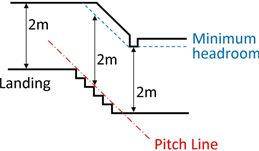This set of Civil Engineering Drawing Multiple Choice Questions & Answers (MCQs) focuses on “House Design and General Arrangement”.
1. Which among the following cannot be a foundation type?
a) Mud concrete with brick aggregate or kankar
b) Weak cement concrete of 1:8:16 with brick ballast
c) Rammed kankar or rammed brick ballast well compacted adding water, during ramming
d) Aggregates and Portland cement
View Answer
Explanation: A foundation (or, more commonly, base) is the element of an architectural structure which connects it to the ground, and transfers loads from the structure to the ground. Foundations are generally considered either shallow or deep.[1] Foundation engineering is the application of soil mechanics and rock mechanics (Geotechnical engineering) in the design of foundation elements of structures.
2. In village housing ______________ D.P.C should be used.
a) 1.5 cm
b) 2 cm
c) 6 cm
d) 0.5 cm
View Answer
Explanation: 2 cm (3/4’’) thick damp proof course should be provided at the plinth level with cement mortar of 1:2 proportion or two coats of asphalt painting may be applied as D.P.C.
3. For village housing which cannot be used as a superstructure?
a) Burnt brick or stone in mud mortar
b) Burnt brick or stone in lime mortar
c) Sundried brick in mud mortar
d) Clayey burnt brick
View Answer
Explanation: A superstructure is an upward extension of an existing structure above a baseline. This term is applied to various kinds of physical structures such as buildings, bridges, or ships having the degree of freedom zero.
4. Which is not a type of stabilized soil mud walls?
a) Lime stabilized
b) Cement stabilized
c) Bitumen stabilized
d) Coal stabilized
View Answer
Explanation: Lime stabilized – With 5% by weight of soil.
Cement stabilized – With 3 to 5% of cement plus 1.5% lime by weight of soil for making rammed wall or for making stabilized soil bricks.
Bitumen stabilized – With 5% cut-black of 80/100 bitumen of janta emulsion.
5. Which is a type of soil brick moulding block machine?
a) Elson block Master machine
b) Standard penetration machine
c) High strength compression machine
d) Brick cutter machine
View Answer
Explanation: Elson block Master machine – Four sizes of blocks 9” * 41/2” * 3”, 12” * 9” * 4”, 12” * 6” * 4” can be made by this machine.
6. As per I.S. 456 – 1978, the pH value of water shall be?
a) Less than 6
b) Not less than 6
c) Equal to 6
d) Equal to 7
View Answer
Explanation: Water used for mixing and curing shall be clean and free from injurious amounts of oils, acids, alkalis, salts, sugar, organic materials or other substances that may be deleterious to concrete or steel.
7. There is no difference between interior design and interior decoration.
a) True
b) False
View Answer
Explanation: Interior design: Interior designer have technical expertise to know the vast array of options and give creative solutions to the space they use for design
• Interior decorating: It is about using various forms of colour and accent to make particular space more visually appealing.
8. In mud roofing the soil for mud layer will consists of 50% sand, mixed with 5% janta emulsion or asphalt by weight.
a) False
b) True
View Answer
Explanation: The mud layer is supported over 2 cm to 2.5 cm thick country wood planks supported over country wood beams 10 cm * 6 cm or 12 cm * 7.5 cm spaced 45 cm to 60 cm centres.
9. Chowkhat shall be 7.5 cm* 7.5 cm of country wood fixed with wooden pegs holds fasts.
a) False
b) True
View Answer
Explanation: Wooden pegs and concealed faces of chowkhat shall be painted with two coats of hot coltar. Leaves or shutters shall be braced battened type of 2.5 cm thick country wood.
10. The minimum head room over a stair must be?
a) 100 cm
b) 300 cm
c) 160 cm
d) 203 cm
View Answer
Explanation: The minimum headroom in all parts of the stairway shall not be less than 6 feet 8 inches (2032 mm) measured vertically from the sloped line adjoining the tread nosing or from the floor surface of the landing or platform on that portion of the stairway.

11. The minimum thickness of a flat slab is taken?
a) L/36 for end panels without drops
b) L/32 for end panels without drops
c) 13 cm
d) L/36 for end panels without drops, L/32 for end panels without drops and 13 cm
View Answer
Explanation: A flat slab is a two-way reinforced concrete slab that usually does not have beams and girders, and the loads are transferred directly to the supporting concrete columns.
Sanfoundry Global Education & Learning Series – Civil Engineering Drawing.
To practice all areas of Civil Engineering Drawing, here is complete set of 1000+ Multiple Choice Questions and Answers.
If you find a mistake in question / option / answer, kindly take a screenshot and email to [email protected]
- Check Civil Engineering Drawing Books
- Check Civil Engineering Books
- Practice Civil Engineering MCQs
- Apply for Civil Engineering Internship
